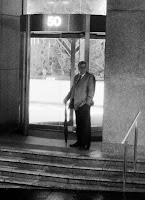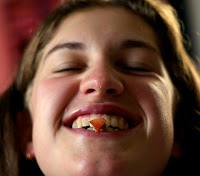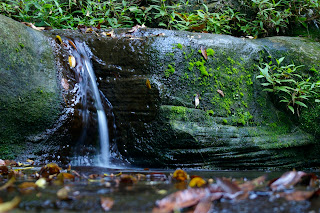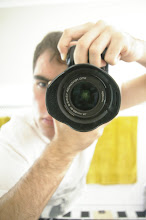noticed that big dial with a whole bunch of symbols on it. Maybe
you've even read the manual (smart cookie) and used some of the pre
programed modes for something like sports or macro.
All of these program modes can be used to simply make your life
easier, or to give you more control over how your photos look. We'll
look at exactly what those guys do a bit futher down.
Camera Modes
There are three other modes available on many compact cameras and all
dslrs which are very useful. These are Av, Tv and M, or respectively
aperture priority, shutter speed priority and manual modes. The first
two are "semi auto" modes. You can fix one or two elements of
exposure, and the camera will automatically adjust the final element to
achieve an exposure based on the ambient light levels. For example in
aperture priority (Av) mode, you would select an F stop, and optionaly
an ISO, and so the camera would select an appropiate shutter speed for
a correct exposure. In shutter speed priority, you would select a
shutter speed, and the camera would adjust the aperture to an f stop
suitable for the ambient light.
There are a few standard modes that you will see on most cameras, including "auto", macro, landscape, sports and portrait.
Auto mode: This basicly turns the camera into a ol' big point and shoot. It's useful for when someone else needs to take a picture with your camera, and doesn't know the first thing about photography, but offers you hardly any control over how or where the camera exposes. Just press the button and the camera figures out the rest. It's ok to spend some time in this mode when you're learning how to use your DLSR, but mastering some of the other modes it gives you will help give you more control over your photos.
Sports mode: gives preference to a high shutter speed to freeze fast
moving objects. It does this by opening up to a wide aperture and
increasing the ISO to allow a typical shutter speed faster than 1/1000
of a second.
Macro mode: sets the preferred focus point to the closest object to the
lens. Useful for capturing fine details of a scene and small stuff like insects or flowers closeup..
Portrait mode: sets the aperture to a maximum value(decreases the F stop number) , to minimise the depth of field. This turns the background into an abstract blur, bringing attention to the subjects face (the focus point) which is sharp and clear.
Landscape Mode: Stops down the lens (increases the F stop number) to maximize depth of field, so you can capture a scene with the foreground and background in clear focus. Think about a mountain scene with some flowers in the foreground - using this mode, you could keep both parts of the picture clear and sharp.
Metering Modes
Aren't these cameras smart? Well if you have ever taken a picture of a
snowy scene you will appreciate how easily they can be fooled. See, to
figure out the exposure, the camera uses one of a few
different tricks called "metering modes". The simplest metering mode
is an average metering, where all the brightness of all points in the frame are just
averaged and the exposure set to make that average a shade of
"middle" (18%) grey. This works pretty well for a lot of scenes, but
is pretty easily fooled. For example, a person set against a white
wall will have a much lighter average value than the 18% grey. So what
will the camera do? Try to underexpose the picture so the white is
much closer to that 'middle grey' value. Of course, we really want an
exposure based on the subjects face, and the wall to be much brighter
than middle grey. So what are we going to do?
The easiest solution in this situation is to use another metering mode
called " spot metering". This metering mode bases the exposure on a
very narrow feild, a roughly circular 'spot', in the center of the
frame. Using this metering, the exposure can be set to the subjects
face, letting the wall be exposed to white. Voila.
Another very common metering mode is "Centre weighted", which is basically a hybrid of spot metering and average metering. The brightness in the middle of the frame is considered 3 or 4 times more important than the parts around the edges of the frame when determing the exposure. Again, in most situations this will ensure the subject has a good exposure, but will also try to not horribly over or under expose the other parts of the image. Either this or spot metering is a good option when your subject is going to have a very different exposure than its surroundings.
Perhaps the most commonly used metering mode is "Matrix Metering". No, it's not related to the enslavement of the human race. The camera measures the exposure at several points in the scene, then does it's little magic tricks to figure out the best exposure based on those points. Thats a pretty vague explaination, but it can vary from camera to camera in exactly how it determines that exposure, and can do so somewhat unpredicataby. However, it will tend to produce the most accurate exposures under most situations if you're not sure where to base your exposure around. Think of it as the "Auto" mode of the metering systems, you don't really think about exactly how it figures it out for you, but it will get it right most of the time.
One other thing worth knowing about the automatic metering modes is the EV or "exposure compensation" function. Sometimes, you'll notice the camera consistantly under or over exposes some types of scenes, even in matrix metering. The classic example is a family shot against a snowwy background - the camera sees all that bright white snow, and tries to dull it down. Problem is, now you've gone and underexposed your subjects.
EV allows you to tell the camera "you need to expose this scene so it's one stop brighter than you would normaly" by dialing in 1 stop of EV. A -1 EV would darken the cameras automatic exposure one stop. On low end DSLRs adjusting EV is often quicker and more intuitive for some people than changing metering modes, so do consider it as an alternative when adjusting exposure.
There you have it, you now know how to control your cameras automatic expsoure functions, and pick the best modes for your subject matter. Pretty neat, no? Now get out and take some pictures, but don't forget to keep on licking.



